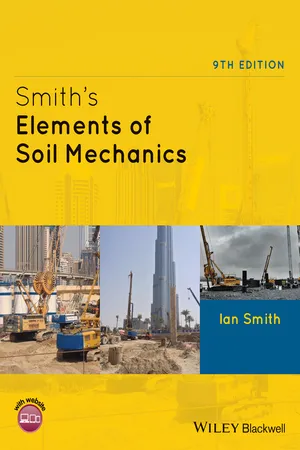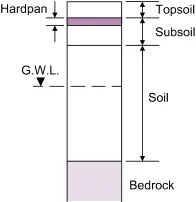
- English
- ePUB (mobile friendly)
- Available on iOS & Android
Smith's Elements of Soil Mechanics
About this book
The 9th edition maintains the content on all soil mechanics subject areas - groundwater flow, soil physical properties, stresses, shear strength, consolidation and settlement, slope stability, retaining walls, shallow and deep foundations, highways, site investigation - but has been expanded to include a detailed explanation of how to use Eurocode 7 for geotechnical design.
The key change in this new edition is the expansion of the content covering Geotechnical Design to Eurocode 7. Redundant material relating to the now defunct British Standards - no longer referred to in degree teaching - has been removed.
Building on the success of the earlier editions, this 9th edition of Smith's Elements of Soil Mechanics brings additional material on geotechnical design to Eurocode 7 in an understandable format. Many worked examples are included to illustrate the processes for performing design to this European standard.
Significant updates throughout the book have been made to reflect other developments in procedures and practices in the construction and site investigation industries. More worked examples and many new figures have been provided throughout. The illustrations have been improved and the new design and layout of the pages give a lift.
- unique content to illustrate the use of Eurocode 7 with essential guidance on how to use the now fully published code
- clear content and well-organised structure
- takes complicated theories and processes and presents them in easy-to-understand formats
- book's website offers examples and downloads to further understanding of the use of Eurocode 7 www.wiley.com/go/smith/soil
Frequently asked questions
- Essential is ideal for learners and professionals who enjoy exploring a wide range of subjects. Access the Essential Library with 800,000+ trusted titles and best-sellers across business, personal growth, and the humanities. Includes unlimited reading time and Standard Read Aloud voice.
- Complete: Perfect for advanced learners and researchers needing full, unrestricted access. Unlock 1.4M+ books across hundreds of subjects, including academic and specialized titles. The Complete Plan also includes advanced features like Premium Read Aloud and Research Assistant.
Please note we cannot support devices running on iOS 13 and Android 7 or earlier. Learn more about using the app.
Information
Chapter 1
Classification and Physical Properties of Soils
1.1 Agricultural and Engineering Soil

Topsoil
Subsoil
Hardpan
Soil
Groundwater
1.2 Engineering Definitions
1.2.1 Rock
Table of contents
- Cover
- Table of Contents
- Title page
- Copyright page
- About the Author
- Preface
- Notation Index
- About the Companion Website
- Chapter 1: Classification and Physical Properties of Soils
- Chapter 2: Permeability and Flow of Water in Soils
- Chapter 3: Total and Effective Stress
- Chapter 4: Shear Strength of Soils
- Chapter 5: Eurocode 7
- Chapter 6: Site Investigation
- Chapter 7: Lateral Earth Pressure
- Chapter 8: Retaining Structures
- Chapter 9: Bearing Capacity and Shallow Foundations
- Chapter 10: Pile Foundations
- Chapter 11: Foundation Settlement and Soil Compression
- Chapter 12: Rate of Foundation Settlement
- Chapter 13: Stability of Slopes
- Chapter 14: Compaction and Soil Mechanics Aspects of Highway Design
- References
- Index
- End User License Agreement